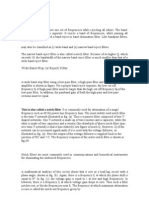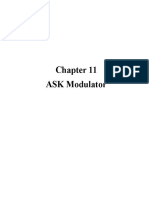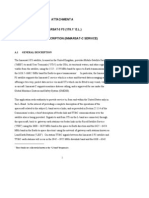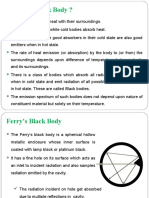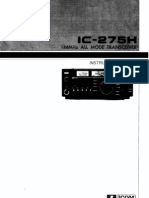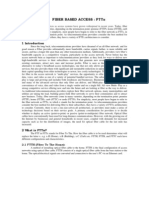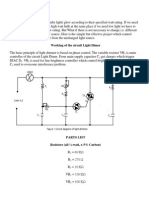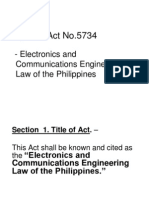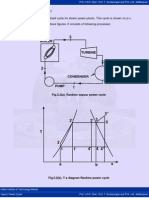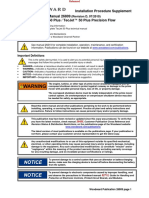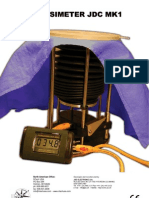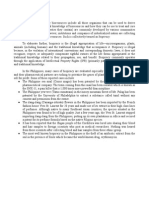0 ratings0% found this document useful (0 votes)
854 viewsBow Tie Antenna
Bow Tie Antenna
Uploaded by
Reen LeeThe document proposes building a bow tie antenna using common materials like 2x4 boards, coat hangers, and aluminum foil. It describes three variations of the bow tie antenna design with different sized elements that are suited for different TV frequency ranges. Diagrams and instructions are provided for assembling a 4-bay version of the antenna, including details on the whisker elements, phase lines, mounting, and optional reflector additions. The document suggests two potential outputs for the antenna design: 1) a 3/4" PVC pipe version without a reflector, or 2) a wood-mounted version using flat backing stand-offs.
Copyright:
© All Rights Reserved
Available Formats
Download as DOCX, PDF, TXT or read online from Scribd
Bow Tie Antenna
Bow Tie Antenna
Uploaded by
Reen Lee0 ratings0% found this document useful (0 votes)
854 views17 pagesThe document proposes building a bow tie antenna using common materials like 2x4 boards, coat hangers, and aluminum foil. It describes three variations of the bow tie antenna design with different sized elements that are suited for different TV frequency ranges. Diagrams and instructions are provided for assembling a 4-bay version of the antenna, including details on the whisker elements, phase lines, mounting, and optional reflector additions. The document suggests two potential outputs for the antenna design: 1) a 3/4" PVC pipe version without a reflector, or 2) a wood-mounted version using flat backing stand-offs.
Original Description:
How to make a Bow Tie Antenna
Copyright
© © All Rights Reserved
Available Formats
DOCX, PDF, TXT or read online from Scribd
Share this document
Did you find this document useful?
Is this content inappropriate?
The document proposes building a bow tie antenna using common materials like 2x4 boards, coat hangers, and aluminum foil. It describes three variations of the bow tie antenna design with different sized elements that are suited for different TV frequency ranges. Diagrams and instructions are provided for assembling a 4-bay version of the antenna, including details on the whisker elements, phase lines, mounting, and optional reflector additions. The document suggests two potential outputs for the antenna design: 1) a 3/4" PVC pipe version without a reflector, or 2) a wood-mounted version using flat backing stand-offs.
Copyright:
© All Rights Reserved
Available Formats
Download as DOCX, PDF, TXT or read online from Scribd
Download as docx, pdf, or txt
0 ratings0% found this document useful (0 votes)
854 views17 pagesBow Tie Antenna
Bow Tie Antenna
Uploaded by
Reen LeeThe document proposes building a bow tie antenna using common materials like 2x4 boards, coat hangers, and aluminum foil. It describes three variations of the bow tie antenna design with different sized elements that are suited for different TV frequency ranges. Diagrams and instructions are provided for assembling a 4-bay version of the antenna, including details on the whisker elements, phase lines, mounting, and optional reflector additions. The document suggests two potential outputs for the antenna design: 1) a 3/4" PVC pipe version without a reflector, or 2) a wood-mounted version using flat backing stand-offs.
Copyright:
© All Rights Reserved
Available Formats
Download as DOCX, PDF, TXT or read online from Scribd
Download as docx, pdf, or txt
You are on page 1of 17
PROPOSAL NO.
1: Bow Tie Antenna
The Bow Tie Antenna is a simple design that can be found in many variations on the web. It can
be made with a 2x4, some coat hangers, aluminum foil and a few other common parts. While
very inexpensive to build, this design is able to pull in stations from 45 and 50 miles away.
PROPOSED BOW TIE ANTENNA DESIGN
Many combinations of antenna elements and reflectors can work well for many different
reception situations which works best in these 3 sizes for TV channels 7 - 52.
In a 4 or 8 bay antenna the 9 1/2" whisker bowtie with 9" bay spacing works better in the mid
VHF-HI channels and UHF channels and is a good overall general purpose choice.
In a 4 or 8 bay antenna the larger 10" whisker bowtie with 9 1/2" bay spacing works better in the
lower VHF-HI channels and lower-mid UHF channels.
In a 4 or 8 bay antenna the smaller 9" whisker bowtie with 8 1/2" bay spacing works best in the
upper VHF-HI channels and mid to upper UHF channels.
9 1/2" whisker bowtie with 9" bay spacing
WHISKER DETAILS
PHASE LINE DETAILS
9 1/2" x 9" phase line long X
9 1/2" x 9" phase line short twist
9" whisker bowtie with 8 1/2" bay spacing
WHISKER DETAILS
PHASE LINE DETAILS
9" x 8 1/2" phase line long X
9" x 8 1/2" phase line short twist
10" whisker bowtie with 9 1/2" bay spacing
WHISKER DETAILS
PHASE LINE DETAILS
10" x 9 1/2" phase line long X
10" x 9 1/2" phase line short twist
REFLECTOR
The reflector can be a very important part of the antenna and can be tailored to get different
results for certain situations. About anything metal will make a reflector in general larger
diameter tubing or strips of flat stock can be spaced further apart and still achieve good rear
rejection as compared to wire. Even good old aluminum / Tin foil strips running horizontally on a
piece of cardboard will do the trick.
The key to a good reflector is the spacing between the horizontal running elements within the
reflector and to make it the right width for the desired channels.
Angled Reflector
Curved Reflector
4 Bay Assembly Instructions
Step 1
Contents should include
(1) paper template
(4) round PVC stand-offs
(1) feed point stand-off
(10) 8-32 x 3/8" screws
(10) 8-32 lock washers
Step 2
Attach the paper template in position on your choice of mounting surface (back bone), make
sure the template is straight and tight. Use the line to help center the template on the mounting
surface (back bone), some tape on each end should secure it into position. The mounting points
are marked on the template with a +, the feed point is the center mark.
Mark or drill the 5 mounting points on your back bone and remove the template
See Figure 1 for details
Step 3
When attaching the stand-offs leave the screws slightly loose during this step.
Attach the feed point stand-off in the center first then attach the (4) round PVC stand-offs in the
remaining spots.
See Figure 2 for details
Step 4
Find the whisker assemblies labeled 1 and 2, these should be attached to the left hand side of
the antenna with 1 in the upper left and 2 in the lower right.
Using the 8-32 x 3/8" screws and lock washers attach the assemblies as shown in Figure 3, only
lightly tighten the screws at this time.
Leave the feed point screws off at this time
Step 5
Find the whisker assemblies labeled 3 and 4, these should be attached to the right hand side of
the antenna with 3 in the upper right and 4 in the lower right.
Using the 8-32 x 3/8" screws and lock washers attach the assemblies as shown in Figure 4, only
lightly tighten the screws at this time.
The feed point screws can be installed loosely at this time to make sure everything is aligned.
During shipping the bow in the crossover phase lines may get tweaked, in order for everything
to line up they may have to be readjusted. If alignment is still a problem recheck your back bone
mounting holes with the template
Step 6
Tighten all the screws except the feed point screws, the feed point screws can be tightened
when your balun or feeder wire is attached.
PROPOSE OUTPUT
We assume to have an output antenna of either of the following:
1. 3/4 PVC using the notched stand-offs without the reflector
2. Mounted to a piece of wood using the flat back stand-offs
http://m4antenna.eastmasonvilleweather.com/index.html
You might also like
- Cyanotype On Glass and CeramicDocument7 pagesCyanotype On Glass and CeramicAntonio Jorge ValerioNo ratings yet
- Ts-590s Service ManualDocument162 pagesTs-590s Service ManualOK1PANo ratings yet
- HydrogeologyLectureNotes v2.3 LRDocument139 pagesHydrogeologyLectureNotes v2.3 LREric Keller100% (3)
- Hexagonal Microstrip Patch AntennaDocument2 pagesHexagonal Microstrip Patch AntennaAli ZaidiNo ratings yet
- ANTENNADocument58 pagesANTENNALycka TubierraNo ratings yet
- 2SC5551 LZ1AQ Loop AmplifierDocument4 pages2SC5551 LZ1AQ Loop AmplifierTerry FugateNo ratings yet
- Cell Phone Antenna REPORTDocument12 pagesCell Phone Antenna REPORTnikita kumariNo ratings yet
- Patch Antenna PresentationDocument51 pagesPatch Antenna PresentationMoin KhalidNo ratings yet
- Superheterodyne ReceiverDocument16 pagesSuperheterodyne ReceiverAmrit Raj100% (1)
- Lab 1 Experiment 1 & 2Document18 pagesLab 1 Experiment 1 & 2Harry Hoon100% (1)
- Transistor at Low and High Frequencies - EDC - Unit 3 PDFDocument102 pagesTransistor at Low and High Frequencies - EDC - Unit 3 PDFanjanaNo ratings yet
- Notch FilterDocument2 pagesNotch Filterlmorales74No ratings yet
- BroadBand Antennas and Traveling Wave AntennasDocument36 pagesBroadBand Antennas and Traveling Wave AntennasVeli100% (1)
- Inductance and Capacitance Meter Adapter Using 74HC132Document6 pagesInductance and Capacitance Meter Adapter Using 74HC132Miguelangel Bravo MigoneNo ratings yet
- Lecture 23 Oblique Incidence and ReflectionDocument21 pagesLecture 23 Oblique Incidence and Reflectionvaldesc_tolNo ratings yet
- 2m BP Filter-Yu1lmDocument5 pages2m BP Filter-Yu1lmshubhamformeNo ratings yet
- Henry 4K-2 RF Linear AmplifierDocument35 pagesHenry 4K-2 RF Linear Amplifierw9fe100% (1)
- Monopole Antenna ProjectDocument28 pagesMonopole Antenna ProjectAkram SarrawyNo ratings yet
- Home 2.4ghzDocument12 pagesHome 2.4ghzjovicaradNo ratings yet
- Chapter SixDocument5 pagesChapter Sixyunus memonNo ratings yet
- Modul ASK Mod - DemodDocument45 pagesModul ASK Mod - DemodfarrasNo ratings yet
- DX 5000 Plus User Manual NewDocument17 pagesDX 5000 Plus User Manual NewclaudiodelbiancoNo ratings yet
- Darlington PairDocument5 pagesDarlington PairHubert Sheldon Diaz100% (1)
- Yaesu G450Document12 pagesYaesu G450neosspn100% (1)
- Service Manual: Panel Assy (A62-1187-13) Knob (VOL) (K29-9498-03) Knob (ENC) (K29-9499-03)Document50 pagesService Manual: Panel Assy (A62-1187-13) Knob (VOL) (K29-9498-03) Knob (ENC) (K29-9499-03)Heru susantoNo ratings yet
- TX RX Sequencerv2Document9 pagesTX RX Sequencerv2Zulu Bravo MikeNo ratings yet
- The Network Devices FunctionDocument2 pagesThe Network Devices FunctionJhea ArponNo ratings yet
- Several Mixers PDFDocument4 pagesSeveral Mixers PDFRolandoIgorLeiva100% (1)
- Shielded Loop Aerials Rev 0Document27 pagesShielded Loop Aerials Rev 0jaynoweNo ratings yet
- Analog Circuits II Lab ManualDocument47 pagesAnalog Circuits II Lab ManualParesh SawantNo ratings yet
- Electronics Lab ManualDocument42 pagesElectronics Lab ManualShikhar DuttaNo ratings yet
- DDS Function GeneratorDocument3 pagesDDS Function GeneratorjckworldNo ratings yet
- History of AntennasDocument23 pagesHistory of AntennasNanda Kumar100% (1)
- Lesson 1 - Evolution of Microprocessor PDFDocument59 pagesLesson 1 - Evolution of Microprocessor PDFFrancis del RosarioNo ratings yet
- 0207040Document3 pages0207040Munte si mareNo ratings yet
- A Superregen Receiver For FM Broadcast or Aircraft Band AM ReceptionDocument4 pagesA Superregen Receiver For FM Broadcast or Aircraft Band AM ReceptionNestor EscobarNo ratings yet
- HLA300-Manual Rel 120Document0 pagesHLA300-Manual Rel 120asfendianosNo ratings yet
- Hexbeam Antenna PDFDocument5 pagesHexbeam Antenna PDFWalter Artur Artur MendesNo ratings yet
- Antennas and Wave Propagation Nov 2007 Question PaperDocument8 pagesAntennas and Wave Propagation Nov 2007 Question Paperelimelek75% (4)
- Klystron SDocument17 pagesKlystron SUrs Amarjith Singh75% (4)
- 50 TOP MOST Electromagnetic Induction - Electrical Engineering Multiple Choice Questions and Answers Electrical Engineering Multiple Choice Questions PDFDocument15 pages50 TOP MOST Electromagnetic Induction - Electrical Engineering Multiple Choice Questions and Answers Electrical Engineering Multiple Choice Questions PDFSIVAKAMINo ratings yet
- Log PeriodicDocument20 pagesLog Periodicmgoldiieeee100% (1)
- Antenna and Ground SystemDocument8 pagesAntenna and Ground SystemDefaultAnomolyNo ratings yet
- Strowger SwitchDocument14 pagesStrowger Switchjeet259100% (1)
- Twisted Pair ElectromacDocument13 pagesTwisted Pair ElectromacAdan Rulo PerezNo ratings yet
- Lesson PRC150Document16 pagesLesson PRC150tomfriisNo ratings yet
- 3F3 Tech NarrativeDocument28 pages3F3 Tech NarrativeMichael MarciniakNo ratings yet
- Folded Bow-Tie AntennaDocument8 pagesFolded Bow-Tie AntennaPunyatoya RautarayNo ratings yet
- Aa3Rl - Transmission Line Calculator: Input Data: Output DataDocument5 pagesAa3Rl - Transmission Line Calculator: Input Data: Output DataNd ReyesNo ratings yet
- What Is A Black Body ?Document82 pagesWhat Is A Black Body ?Ashwani RatheeNo ratings yet
- 3719 DatasheetDocument6 pages3719 DatasheetAnkit Gupta100% (2)
- Icom IC-275H Instruction ManualDocument66 pagesIcom IC-275H Instruction ManualYayok S. AnggoroNo ratings yet
- 4nec2 Antenna Simulation EnglishDocument13 pages4nec2 Antenna Simulation EnglishTooba SaharNo ratings yet
- AMA - 300 - Aerial Measuring Device 5-2150MHz PDFDocument1 pageAMA - 300 - Aerial Measuring Device 5-2150MHz PDFchaparalNo ratings yet
- ANTENNA Term DefinitationDocument17 pagesANTENNA Term DefinitationShailendra Sapkota100% (1)
- Data and Computer Communications: Tenth Edition by William StallingsDocument42 pagesData and Computer Communications: Tenth Edition by William StallingsDinah Pearl MadeloNo ratings yet
- Fiber Based AccessDocument5 pagesFiber Based AccessbinnyNo ratings yet
- TH 3 MKDocument20 pagesTH 3 MKAdrianoAmadorNo ratings yet
- 48 Inch Az El Instructions 01242020 New RibsDocument20 pages48 Inch Az El Instructions 01242020 New RibsCarlosAgustoPinedaSanchezNo ratings yet
- KG4JJH_6m_4el_Quad (1)Document10 pagesKG4JJH_6m_4el_Quad (1)liokleinNo ratings yet
- Travel AntennaDocument5 pagesTravel Antennanw2sNo ratings yet
- 20M6LDocument11 pages20M6Ljavier.carroNo ratings yet
- Light DimmerDocument4 pagesLight DimmerReen LeeNo ratings yet
- How To Pass The Ece Board ExamDocument7 pagesHow To Pass The Ece Board ExamReen LeeNo ratings yet
- Bow Tie AntennaDocument17 pagesBow Tie AntennaReen LeeNo ratings yet
- New CCNA Commonly Asked QuestionsDocument24 pagesNew CCNA Commonly Asked QuestionsReen LeeNo ratings yet
- Crossover Cable: (Estimated Time: 50 Minutes) ObjectivesDocument10 pagesCrossover Cable: (Estimated Time: 50 Minutes) ObjectivesReen LeeNo ratings yet
- FetDocument20 pagesFetReen Lee0% (1)
- DiodeDocument37 pagesDiodeReen LeeNo ratings yet
- Ecelaws-Ra5734 9292Document28 pagesEcelaws-Ra5734 9292Achilles AldaveNo ratings yet
- A Guide To Electric Vehicle Charging SolutionsDocument44 pagesA Guide To Electric Vehicle Charging SolutionsLaviniu S. Nacu50% (6)
- Caring Confidential & FreeDocument10 pagesCaring Confidential & FreeJim KerrNo ratings yet
- FAQ's Plan H With AnswersDocument23 pagesFAQ's Plan H With AnswersVaibhav Singh100% (1)
- Basic Counselling SkillsDocument3 pagesBasic Counselling Skillsjiajun898No ratings yet
- 2 - RankinecycleDocument4 pages2 - RankinecycleamdevaNo ratings yet
- Working With Feelings & Strong Emotions - MasterDocument7 pagesWorking With Feelings & Strong Emotions - MasterB100% (1)
- Research On Sleep Deprivation Among Filipino Teenage StudentsDocument26 pagesResearch On Sleep Deprivation Among Filipino Teenage StudentsErjoy Constantine RoblesNo ratings yet
- Installation Procedure Supplement Manual 26809 Tecjet ™ 50 Plus / Tecjet™ 50 Plus Precision FlowDocument7 pagesInstallation Procedure Supplement Manual 26809 Tecjet ™ 50 Plus / Tecjet™ 50 Plus Precision FlowKarel GómezNo ratings yet
- Physics Sample PaperDocument6 pagesPhysics Sample PaperfalconalphaworkspaceNo ratings yet
- raindrop_techniqueDocument6 pagesraindrop_techniqueSilvia MarcoNo ratings yet
- Appendix 7 To Chapter 5 Sms Gap Analysis Checklist and Implementation PlanDocument8 pagesAppendix 7 To Chapter 5 Sms Gap Analysis Checklist and Implementation PlanCahaya Yg TerpujiNo ratings yet
- LEG MED The Doctor As A Witness T. Rebosa v2Document6 pagesLEG MED The Doctor As A Witness T. Rebosa v2Rob Licerio100% (1)
- Portrait of A Poet On FireDocument5 pagesPortrait of A Poet On FireAlora CisnerozNo ratings yet
- Digital OOH LED April FinalDocument21 pagesDigital OOH LED April Finalrezowan555No ratings yet
- Porosimetro JDC mk1Document3 pagesPorosimetro JDC mk1motorsoloNo ratings yet
- Sistema de Llenado Rápido CombustibleDocument22 pagesSistema de Llenado Rápido CombustibleHugo VillcaNo ratings yet
- BIO-PIRacy Ethics 10Document3 pagesBIO-PIRacy Ethics 10March ElleneNo ratings yet
- Pages From 5090 - w11 - QP - 22Document1 pagePages From 5090 - w11 - QP - 22Abrar JawadNo ratings yet
- Fd20i EngDocument1 pageFd20i EngSiddique AhmedNo ratings yet
- Phantom Mama - CIRS - 011ADocument16 pagesPhantom Mama - CIRS - 011AMichel FrancoNo ratings yet
- CHAPTERS 1 TO 5 Correlation of Eating Habits To Academic Performance of SHS StudentsDocument43 pagesCHAPTERS 1 TO 5 Correlation of Eating Habits To Academic Performance of SHS StudentsHannah Borromeo100% (2)
- Modified Release Dosage Form: Done By: Lecturer Ahmed AbdulameerDocument19 pagesModified Release Dosage Form: Done By: Lecturer Ahmed Abdulameerمظفر يوسف رشمNo ratings yet
- Fan Indent - BHW June15Document4 pagesFan Indent - BHW June15Rajesh TipnisNo ratings yet
- Fidp (Front Office)Document3 pagesFidp (Front Office)Ryan Jamil B. NodaNo ratings yet
- Vallourec IPC-207Document4 pagesVallourec IPC-207zapspazNo ratings yet
- Covid 19 STEM Module Teacher GuideDocument40 pagesCovid 19 STEM Module Teacher GuideDeasy IrawatiNo ratings yet
- RC ch10Document3 pagesRC ch10Gabrielle FranciscoNo ratings yet











